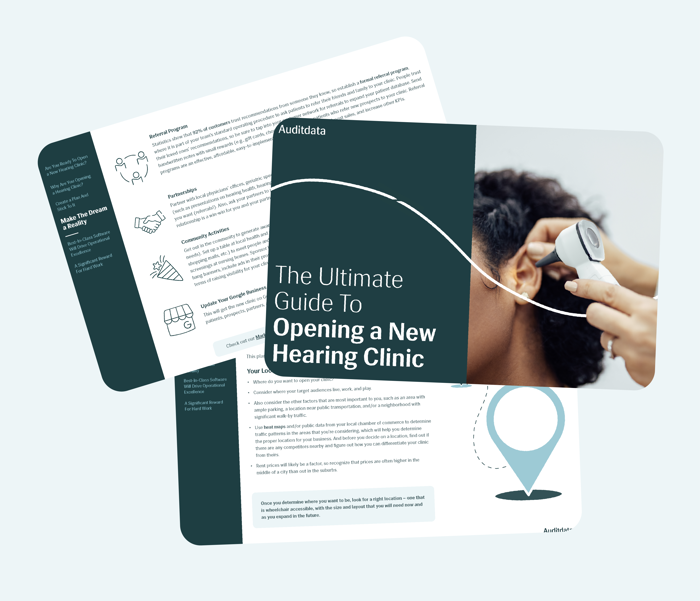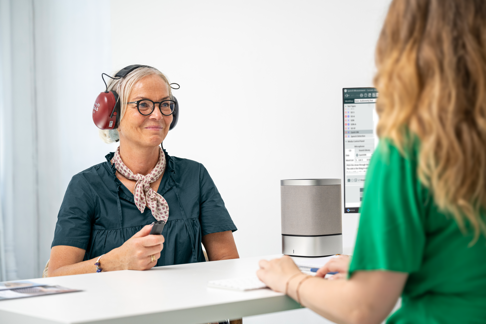
The Trends Behind Audiology Growth in America

The number of Americans ages 65 and older is expected to increase from 58 million to 82 million by 2050 – a dramatic 47% jump. Since age-related hearing loss is the most common reason that people lose their hearing, the growing aging population will create more demand for hearing care in the U.S.
Another important trend is that younger generations are experiencing noise-induced hearing loss from prolonged headphone use, loud concerts, and other loud environments. In fact, recent studies showed that one billion young people have noise-induced hearing loss from listening to loud music.
Hearing care isn’t just targeting seniors anymore. Audiology is becoming preventive, lifestyle-driven, and tech-enabled, changing who seeks care and how they access it.
Key Criteria for Choosing a Great First Clinic Location

The location you pick for your new hearing clinic can significantly impact your success, so consider factors like visibility, accessibility, convenience, and neighborhood demographics.
For instance, since aging contributes to hearing loss, look for a location with a large population of seniors to help ensure a solid pipeline of patients and prospects. Carefully research the local competition to determine how many other audiology clinics are in the area, and whether their specialties are similar to what you’ll offer.
Prioritize convenience and accessibility, ensuring that the location you pick is easy for patients and prospects to access, with convenient parking and public transportation nearby. Make sure to pick a spot in a high-traffic area to boost your visibility.
Focus on economic sustainability, comparing rent, wages, and reimbursement structure in different markets. For instance, renting clinic space in the middle of New York City will be significantly more expensive than renting space in a smaller metro market, like Jacksonville, FL, where costs are lower.
Additionally, research the reimbursement structure in the areas you’re considering. Research the demographics and income in these markets, as well, to determine whether your location would be in a high-wealth area where patients can easily afford to buy top-of-the-line hearing aids, or a lower income area where patients may struggle to afford the solutions you’ll offer.
Regulatory simplicity should also factor into your location choice because the speed and cost to get licensed and open your clinic depends largely on regulatory rules and regulations in the area(s) you’re exploring. When considering the best places to start an audiology practice in the USA, understand that Texas has no state income tax and relatively simple entity setup but, in contrast, California imposes complex licensing and labor laws that will make it more challenging to launch a clinic there.
Guide Download
The Ultimate Guide to Opening a New Hearing Clinic
With this guide, you can access expert advice and guidance to help you make your dream of opening a successful hearing clinic a reality.

Strategic Insight: Prioritize Agility Over Size
If you’re launching a new practice, you likely have limited brand awareness, a lean team, and a finite marketing budget. That means your reach and impact will initially be localized. If you’re planning to launch your clinic in a huge city, recognize that it’s easy to get lost in the “noise” unless you have a strong niche, big marketing budget, or well-established partnerships. It’s better to dominate a neighborhood than to be invisible in a city.
Therefore, consider launching in a well-defined, underserved suburb or town where you can become “the hearing care clinic” of the area. Focus on marketing and promotions in your local area and look for hyper-local referrals. Build a strong network in your community. For instance, partner with other local medical practices to boost referrals. Provide extraordinary service and ask your happy patients to refer their loved ones to your practice. In a suburb or town, word-of-mouth can build quickly, helping your practice grow through referrals.
How to Expand Your Audiology Clinic
If you already have a thriving audiology practice, you already have an experienced staff, excellent reputation, and loyal customers. In fact, your business is doing so well that you’re poised to expand to a new location.

Why Expansion Strategy Is Different from Starting
You aren’t starting from scratch this time. You already have a strong reputation, well-established community partners, referral sources, and happy customers. And you have patients, data, referrals, team infrastructure, and operational capacity. You’ve decided that the time is right for expansion, and you’re looking for a new location to support this business growth.
When you’re expanding your business, you’re no longer choosing any market – you’re choosing strategic adjacency. So, what should you consider as you expand?
How to Grow from One Clinic Strategically
Start With Your Own Patient Data
Use CRM or ZIP/postal code data to identify geographic clusters. Determine where your current patients are coming from. Identify patterns that show where there are higher needs for hearing care services and leverage that demand with your new location.
The 30–45 Minute Rule
Keep clinics close enough to share staff, referrals, and operational systems, but not close enough to be redundant. Open the newest clinic within 30-45 minutes of your existing location(s). That way, patients can easily, conveniently be seen in your other clinics, and staff can float between locations, as necessary.
Hub-and-Spoke vs. Scattershot Expansion
In healthcare, the hub-and-spoke model organizes services around a central location (the hub) that coordinates with smaller, connected satellite locations (the spokes). This structure helps optimize resource management across the organization, with shared marketing, scheduling, staffing, etc. The hub-and-spoke model also helps ensure efficient, streamlined, high-quality patient care in all clinic locations.
Alternatively, the scattershot expansion model refers to buying clinics at random, with no discernable strategies, patterns, or shared resources. This haphazard approach leads to operational inefficiencies that can waste precious resources and negatively impact patient care and your clinic’s bottom line.
Buying Out Another Audiology Clinic
If you plan to buy someone else’s clinic, buy wisely. Consider clinics with impeccable reputations and happy customers, that match your service model and are within strategic geographic range. Do thorough research before you commit, looking for signs of a thriving practice – extraordinary clinical reputation, high patient satisfaction ratings, a strong referral network, a desirable location, talented employees, financial stability, and opportunities for growth. Also, identify any potential liabilities, risks, and challenges associated with the business. Review the clinic’s financial records, employee performance reviews, customer satisfaction ratings, etc., and look for any possible red flags.
Best Places to Start Audiology Practice in the U.S.

Texas stands out for its low taxes, rapid population growth, and simple licensing.
Florida is known for having a large aging population, high year-round demand, and multiple underserved zones.
North Carolina offers expanding urban healthcare hubs and Medicaid expansion.
Arizona has a low saturation of hearing clinics in high-retiree suburbs and easy business setup.
California has a high-income population, making it good for niche or flagship clinics.
These states align with important principles: choose where demand is clear, regulation is manageable, and growth can be sustained.
These are just a few examples to illustrate how different states align with key strategic factors. When choosing your location, be sure to evaluate your own priorities, resources, and target patients.
Other Blogs You Might Enjoy

Cybersecurity: Be Prepared – Not Scared: Strengthening Cybersecurity in Hearing Practices
While cybersecurity has become a pressing business issue, many audiology practices don’t have the necessary security measures in place to protect confidential data – including patients’ healthcare and financial information. Does yours?

Best Practices in Audiometry: Achieving Accurate and Consistent Results
Audiometric assessments play a crucial role in diagnosing and managing hearing disorders, making it essential to ensure that the results obtained are both accurate and consistent. This article explores the best practices in audiometry, offering a comprehensive guide to optimize the assessment process and enhance the reliability of outcomes.

9 Proven Tips to Improve Time Management in Hearing Practices
Time management skills in healthcare are critical because your staff is dealing with people’s well-being. In audiology, you’re always busy, and must work diligently and continuously to provide exceptional care and outstanding customer service. This blog outlines 9 proven tips to improve your time management skills and make the most of each day.
Don't Miss Out On the Latest Insights On Audiology
Sign up today to receive exciting updates, tips, and the latest newsletters from Auditdata.